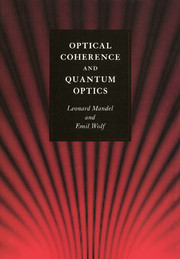Book contents
- Frontmatter
- Contents
- Preface
- 1 Elements of probability theory
- 2 Random (or stochastic) processes
- 3 Some useful mathematical techniques
- 4 Second-order coherence theory of scalar wavefields
- 5 Radiation from sources of any state of coherence
- 6 Second-order coherence theory of vector electromagnetic fields
- 7 Some applications of second-order coherence theory
- 8 Higher-order correlations in optical fields
- 9 Semiclassical theory of photoelectric detection of light
- 10 Quantization of the free electromagnetic field
- 11 Coherent states of the electromagnetic field
- 12 Quantum correlations and photon statistics
- 13 Radiation from thermal equilibrium sources
- 14 Quantum theory of photoelectric detection of light
- 15 Interaction between light and a two-level atom
- 16 Collective atomic interactions
- 17 Some general techniques for treating interacting systems
- 18 The single-mode laser
- 19 The two-mode ring laser
- 20 The linear light amplifier
- 21 Squeezed states of light
- 22 Some quantum effects in nonlinear optics
- References
- Author index
- Subject index
18 - The single-mode laser
Published online by Cambridge University Press: 05 April 2013
- Frontmatter
- Contents
- Preface
- 1 Elements of probability theory
- 2 Random (or stochastic) processes
- 3 Some useful mathematical techniques
- 4 Second-order coherence theory of scalar wavefields
- 5 Radiation from sources of any state of coherence
- 6 Second-order coherence theory of vector electromagnetic fields
- 7 Some applications of second-order coherence theory
- 8 Higher-order correlations in optical fields
- 9 Semiclassical theory of photoelectric detection of light
- 10 Quantization of the free electromagnetic field
- 11 Coherent states of the electromagnetic field
- 12 Quantum correlations and photon statistics
- 13 Radiation from thermal equilibrium sources
- 14 Quantum theory of photoelectric detection of light
- 15 Interaction between light and a two-level atom
- 16 Collective atomic interactions
- 17 Some general techniques for treating interacting systems
- 18 The single-mode laser
- 19 The two-mode ring laser
- 20 The linear light amplifier
- 21 Squeezed states of light
- 22 Some quantum effects in nonlinear optics
- References
- Author index
- Subject index
Summary
Introduction
The idea of making use of the phenomenon of stimulated emission from an atom or molecule for amplification of the electromagnetic field, and then combining the amplifier with a resonator to make an oscillator, is due to Townes and his co-workers (Gordon, Zeiger and Townes, 1954, 1955) and independently to Basov and Prokhorov (1954, 1955). The former constructed the first MASER, or microwave amplifier by stimulated emission of radiation. In 1958 Schawlow and Townes proposed an application of the same principle to the optical domain (Schawlow and Townes, 1958), in which a two-mirror Fabry–Perot interferometer serves as the optical resonator and an excited group of atoms as the gain medium. The first LASER, or light amplifier by stimulated emission of radiation, was constructed by Maiman (1960). The gain medium was ruby, which was excited by a bright flash of light from a gas discharge tube, whereupon the laser delivered a short optical pulse. The first continuously operating – or CW – laser was developed by Javan and his co-workers (Javan, Bennett and Herriott, 1961); it made use of a He:Ne gas mixture, that was continuously excited by a discharge, as the gain medium. This type of laser is still widely used today. Since that time many different kinds of laser have been developed, ranging in wavelength from the infrared to the ultraviolet. Some produce light at several different frequencies at once, and some are tunable over a wide range.
- Type
- Chapter
- Information
- Optical Coherence and Quantum Optics , pp. 900 - 975Publisher: Cambridge University PressPrint publication year: 1995



